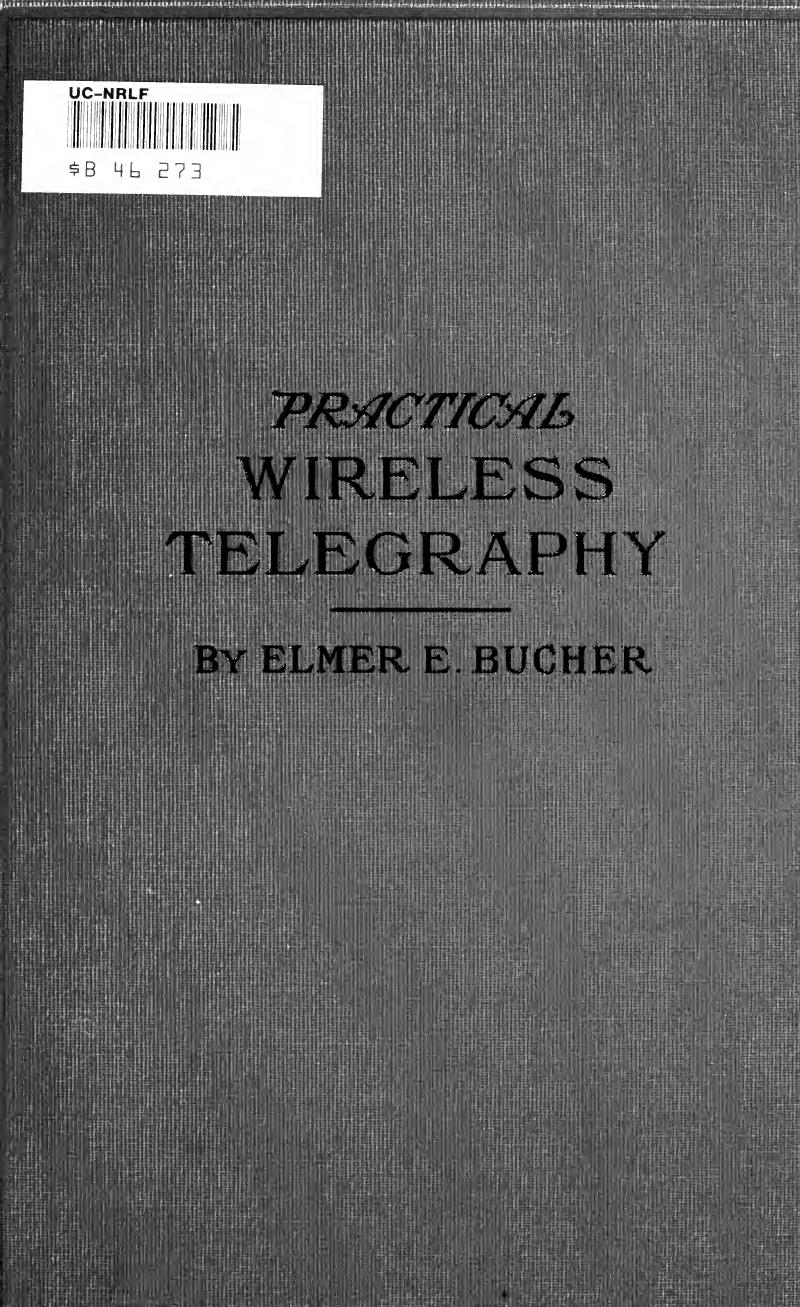Practical wireless telegraphy : a complete text book for students of radio communication by Bucher Elmer Eustice 1885-

Author:Bucher, Elmer Eustice, 1885-
Language: eng
Format: epub, pdf
Tags: Telegraph, Wireless, Radio
Publisher: New York : Wireless Press, inc.
rig
"Dead-end" or "End" Turns of a Receiver Tuning Coil.
189—Showing the Turn
Fig.
Position of an End Switch.
respond more freely to one impressed frequency than to another. Now, it is found by experiment that a crystal detector, such as the carborundum rectifier, gives the loudest response in the receiving telephone when the maximum possible voltage for a given group of incoming oscillations is impressed upon it, and generally a secondary receiver circuit in which inductance predominates gives the maximum possible voltage. Then if a secondary circuit minus a shunt condenser is constructed so that its natural oscillation frequency accords with the frequency of the oscillations flowing in the transmitter aerial, maximum response is secured. All this may be summed up by saying that a secondary receiver circuit lacking a shunt variable condenser functions similar to one in which it is supplied, the necessary capacity being found in the self-capacity of the coil. A primary winding having distributed capacity is somewhat objectionable for use in tuning circuits, because an appreciable amount of current will oscillate through the unused turns, particularly if the frequency of the incoming signal equals the natural frequency of the coil. Coils made of fine wire or those wound irregularly tend to reduce the effects of distributed capacity.
147. The End Turns of a Receiving Tuner and End Turn Switches.—
In the preceding paragraph the effect of distributed capacity in the windings of a tuning coil was discussed, and the fact mentioned that a coil of given dimensions may have a well-defined time period of oscillation and may therefore oscillate more freely to an impressed current of a particular frequency.
Assume that such a coil is connected in series with the antenna circuit shown in Fig. 188 and that for resonant adjustment to the wave length of 600 meters the turns between points A and B only are required. The remaining turns from B to C are therefore useless for this particular wave length, and should the coil have a natural time period of oscillation corresponding to the wave of 600 meters, an appreciable amount of current would oscillate backward and forward through the unused or end turns. This in effect amounts to placing a secondary circuit in resonance with the antenna circuit and results in the absorption of some of the energy of the oscillations.
If the antenna system were only to be tuned to the maximunxwave length of 600 meters, the additional turns on the coil B to C would not be required, but inasmuch as the aerial system may have to be tuned to various wave lengths up to 3,000 or 4,000 meters, the full number of turns are required for the winding.
If then, for example, the coil A, C, is interrupted at the point D, E, as shown in Fig. 189, the unused turns of the winding are conductively disconnected from the used turns and
* Note also the radio-frequency amplifier described in paragraph 226. Note also diagram Fig. 296. * Explanation according to Armstrong.
Download
Practical wireless telegraphy : a complete text book for students of radio communication by Bucher Elmer Eustice 1885-.pdf
This site does not store any files on its server. We only index and link to content provided by other sites. Please contact the content providers to delete copyright contents if any and email us, we'll remove relevant links or contents immediately.
| Automotive | Engineering |
| Transportation |
Whiskies Galore by Ian Buxton(41524)
Introduction to Aircraft Design (Cambridge Aerospace Series) by John P. Fielding(32885)
Small Unmanned Fixed-wing Aircraft Design by Andrew J. Keane Andras Sobester James P. Scanlan & András Sóbester & James P. Scanlan(32569)
Craft Beer for the Homebrewer by Michael Agnew(17927)
Turbulence by E. J. Noyes(7693)
The Complete Stick Figure Physics Tutorials by Allen Sarah(7135)
Kaplan MCAT General Chemistry Review by Kaplan(6590)
The Thirst by Nesbo Jo(6432)
Bad Blood by John Carreyrou(6271)
Modelling of Convective Heat and Mass Transfer in Rotating Flows by Igor V. Shevchuk(6219)
Learning SQL by Alan Beaulieu(6029)
Weapons of Math Destruction by Cathy O'Neil(5823)
Man-made Catastrophes and Risk Information Concealment by Dmitry Chernov & Didier Sornette(5642)
Digital Minimalism by Cal Newport;(5388)
Life 3.0: Being Human in the Age of Artificial Intelligence by Tegmark Max(5182)
iGen by Jean M. Twenge(5157)
Secrets of Antigravity Propulsion: Tesla, UFOs, and Classified Aerospace Technology by Ph.D. Paul A. Laviolette(4974)
Design of Trajectory Optimization Approach for Space Maneuver Vehicle Skip Entry Problems by Runqi Chai & Al Savvaris & Antonios Tsourdos & Senchun Chai(4837)
Electronic Devices & Circuits by Jacob Millman & Christos C. Halkias(4741)
